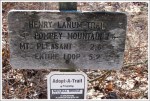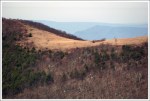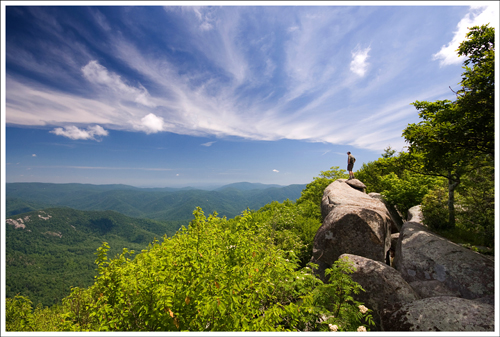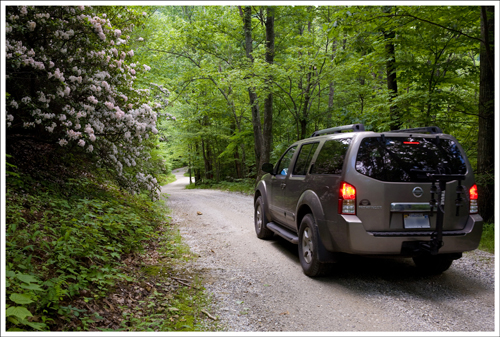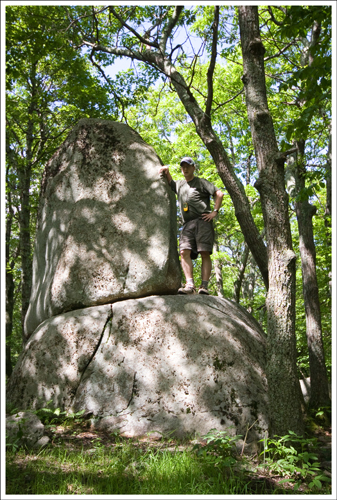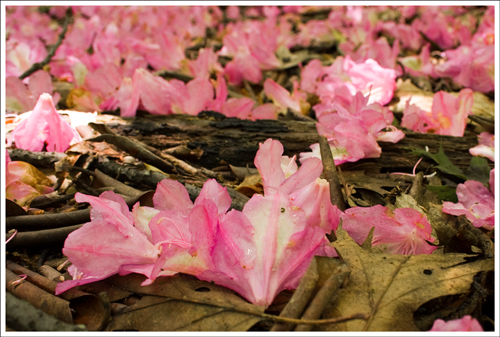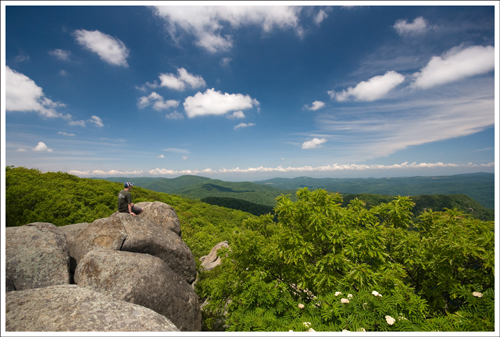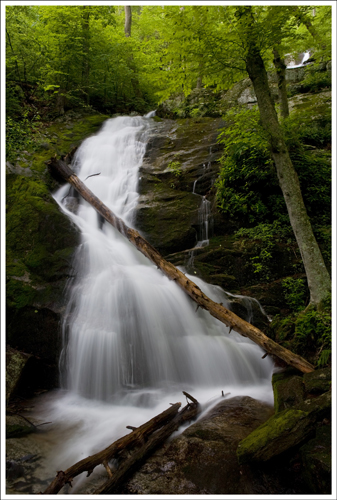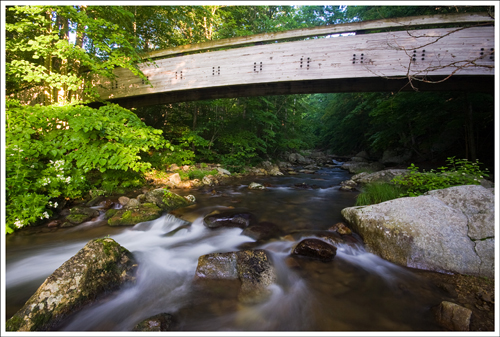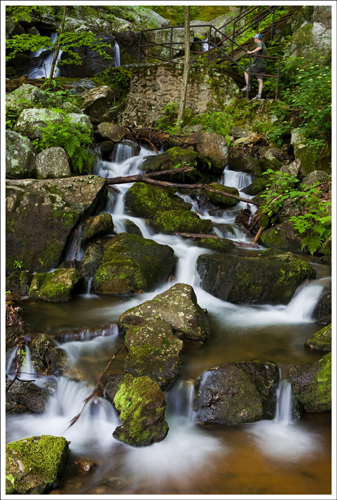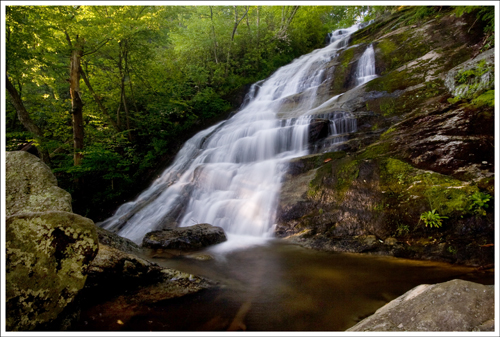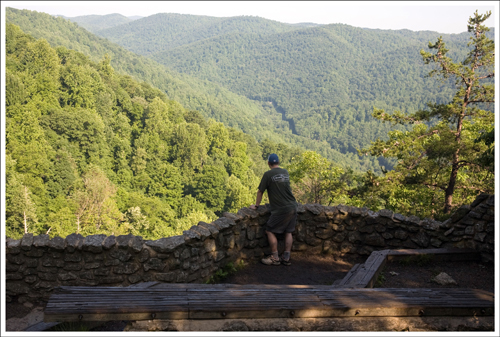This 5.4 mile loop hike takes you to the beautiful double summit of Mount Pleasant, across Pompey Mountain and then back down to your car.
NOTE (2/26/17): A recent hiker reported that the fall forest fire in this area did severe damage to this trail system. He reports that many of the blazes have been destroyed and the trail is hard to follow.

Christine Says…
When we hiked the Cole Mountain trail last fall, we made a mental note to return to the area sometime to do the Mount Pleasant hike. We’re so glad we did. The hike up Mount Pleasant provides gorgeous views from both its east and west summits. We had a crystal clear day and could see for miles in every direction.
We started out on our hike a couple hours later than we normally do. The delayed start turned out to be quite fortuitous. As we drove down Wiggins Spring Rd toward the trailhead, we saw 15-20 cars parked near the AT crossing and Cole Mountain trail. We assumed that they were a group camping and hiking on the Cole Mountain trail and were thankful not to sharing trail with such a large crowd. A little further down the road, the Mount Pleasant parking lot was empty with the exception of one frost-covered car that had obviously been left there overnight.
We started down the trail. It was icy and muddy, but pleasantly flat for the first mile. After we crossed a small stream, the upward climb began in earnest. It wasn’t terribly difficult or steep climbing, but it was constant for the rest of the way to the summit. Much of the trail was wet/soupy and covered with a thick layer of leaves. There were several places that the trail was tough to follow, but I imagine that once more hikers pass this way, the trail will become clear again.
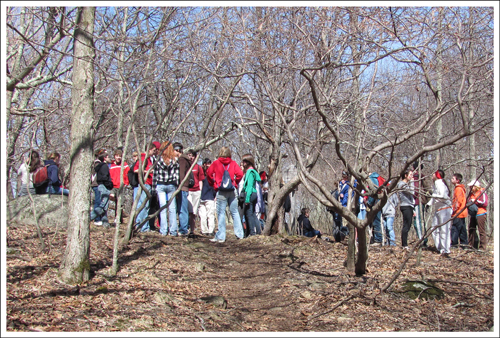
At around the 1.5 mile mark, we started hearing distant voices in the woods – lots of distant voices. I looked at Adam and said “I don’t think all those people are on Cole Mountain after all.” At 1.9 miles we came to a trail junction being used as a rendezvous point for about 30 kids on a church youth group trip. I have never heard people being so loud in the woods. One group of three boys thought it was hilarious to repeatedly scream “NINKOMPOOP” at the top of their lungs as they headed down the trail.
After we cut through the crowd, we took a right turn and followed the spur trail up to the mountain top. On the way up, we passed about 20 more hikers from the same youth group. As I mentioned earlier, it was lucky we started our hike late, or else we might have been sharing the beautiful mountaintop with 50 shrieking kids. As it turned out, we had the view all to ourselves.
At the summit, there was a small sign with arrows pointing to the east summit and the west summit. We headed west first. The west summit is on a dramatic outcropping of rocks. It provides an expansive, layered mountain vista, including a great look at the bald summit of Cole Mountain. The east summit is also lovely, albeit a little less dramatic. The view is mostly valley and farmland.
We stayed at both summits longer than we normally would. We wanted to put some time and distance between ourselves and the youth group. We took in the view, had a snack and a drink and took a few photos.
The hike back down from the summit brings you back to the trail junction, where instead of turning left to hike back down the way you came up, you continue straight on the Henry Lanum Loop Trail. This trail will almost immediately begin to climb upward again – over the summit of Pompey Mountain. There are no views from this mountain. After reaching the peak of Pompey, there is a short, but steep downhill. The trail from this point on is a mix of uphill and downhill walking until you’re eventually returned to your car. On this loop, you definitely spend more time hiking uphill than you do hiking downhill. If you want less climbing, I recommend hiking this as an out-and-back. It won’t make the hike much shorter, but will significantly cut down on the climbing.
Adam Says…
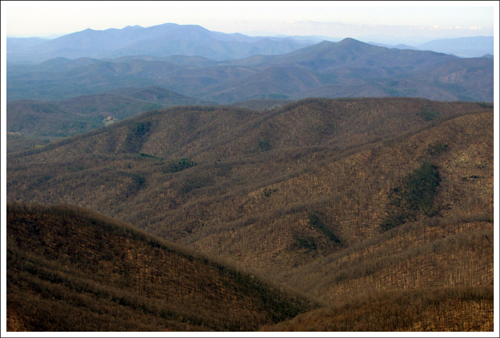
The hike up Mount Pleasant is one of the better hikes for views in Virginia. If you have a few days to spend in this area, I would also recommend doing this and the Cole/Cold Mountain hike. This area has some gorgeous mountains around you and the reason for the town nearby to be named Buena Vista. When you combine both views from the two overlooks at Mount Pleasant, you get nearly a full view of the area around you.
The hike was not too difficult. I would recommend that if just want to see the views, complete this hike as an out-and-back hike. When we did this hike as a loop, we added on the trip up Pompey Mountain, but there are not any scenic views or much of note on the way back.
One interesting note about this trail is that you may see some remnants of fallen American chestnut trees throughout your hike. They once covered this area until a fungal blight wiped out their population. It is interesting to think how different these views would have looked in a canopy of chestnuts.
To know which way to start the hike can be a little tricky. There are lots of paths away from the parking lot, including two blue-blazed trails marking the Henry Lanum Trail. You will start the hike at the blue-blazed trail that starts off very flat. The other blue-blazed trail looks clearly uphill and is the path that you will return. We felt this trail was a little hard to follow at times and could have used a few more blue blazes painted. There were times we were unsure if we were still on the correct trail.
The trail starts off relatively flat or going downhill for about the first 1.5 miles. Around 1.3 miles, you see a wooden sign that reads “Trail”, but other than that it is fairly easy to follow. Keep following the blue blazes and you will eventually need to cross a couple of areas that may include small streams. We didn’t have any trouble hopping across and I’m guessing that most of the year, it is relatively dry. After you cross the stream, the trail will lead to the climb up to the summit. Around 2.0 miles you will reach a junction sign that shows the Mount Pleasant Summit Spur Trail to the right. This summit trail continues for about .4 miles until you reach the saddle. A sign at the junction here shows there are overlooks to the West and East. The western summit takes about .1 mile to reach and you will need to climb up the rock outcropping for the great views. The eastern summit is closer and doesn’t require any climbing, but we were both more impressed with the views from the western summit. Once you take some time to soak in the views, go back the way you came to reach the junction sign for the Summit Spur Trail. If you want to continue the loop back to your car, you will continue straight on the Henry Lanum Trail. This leads you through the forest for some more uphill climbs over Pompey Mountain. From the junction sign, it is about 1.9 miles back to your vehicle.
Luckily, we were able to avoid the crowds of screaming teenagers that clearly don’t understand Leave No Trace principles. Once more of the leaves start spreading their leaves, the summit overlooks will give you absolutely amazing views.
Trail Notes
- Distance – 5.4 miles – loop.
- Elevation Change –1350 feet.
- Difficulty – 3.5 This loop has long, moderate uphills and shorter, steeper downhills. It’s one of those trails that makes you feel like you’re always walking uphill.
- Trail Conditions – 3. The trail is in decent shape. There was a lot of mud when we hiked.
- Views –5. The east/west double summit of Mount Pleasant is magnificent
- Waterfalls/streams –1. There is a small stream in the woods on the departing arm of the loop.
- Wildlife – 0. Nothing, but doubtlessly the large church group scared any wildlife away. We did see lots of juncos along the trail.
- Ease to Navigate – 2.5. In several spots, the trail was hard to find under thick leaves and blowdowns. Some blazes are starting to wear away and it might be easy to miss turns. I think ease of navigation will improve as spring/summer approach and hikers wear the path down.
- Solitude – 3 . For today, we had a 0 for solitude, but we just had a bit of poor timing. Being the namesake hike for this area, you will likely run into some other people on the hike.
Directions to trailhead:
Follow I-81 to Buena Vista (exit 188A). After passing through the town of Buena Vista, follow US60/Midland Trail for 9.5 miles. Take a left on Coffeytown Rd. Follow Coffeytown for just under two miles. Take a right on Wiggins Spring Rd. Follow Wiggins Spring for 3 miles. This road will turn to a rugged gravel road. Follow the signs for the Mt. Pleasant trailhead. There is a small parking lot at the trailhead.

